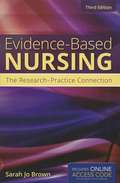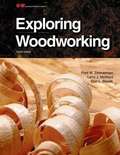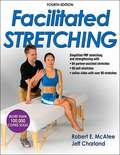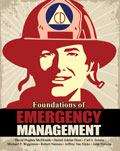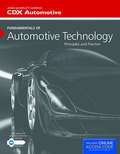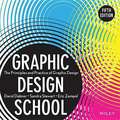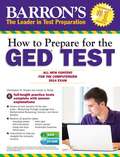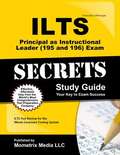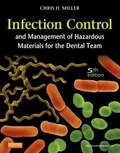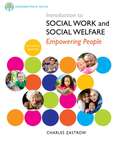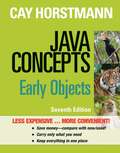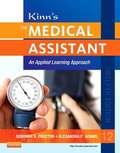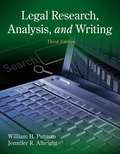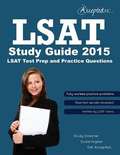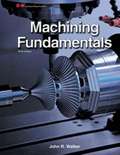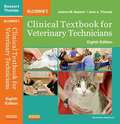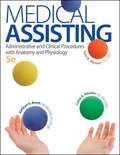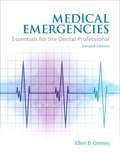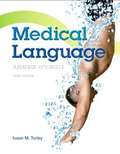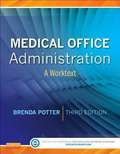- Table View
- List View
Evidence-Based Nursing: The Research-Practice Connection (Third Edition)
by Sarah Jo BrownEvidence-Based Nursing: The Research-Practice Connection, Third Edition introduces students to research methods and evidence-based practice (EBP). Written in an accessible style, the content moves readers through understanding how research is produced to appraisal at the critical thinking level. Timely information links evidence-based practice to recent work in the Safety and Quality programs that are underway in healthcare and nursing. Key Features:* Offers five common research designs, systematic reviews, and clinical practice guidelines by using a consistent, easy-to-read "Why-How-What" approach. * Exemplar research reports include "Profile and Commentary" that explain results of studies and help students better understand the methodological components of a study Accompanied by Instructor Resources:* Save time with a Test Bank and sample syllabus* Encourage critical thinking using additional learning activities, including discussion questions and small group assignments * Plan classroom lectures using PowerPoint Presentations created by the authorNavigate eFolio Now Available! Navigate eFolio: Evidence-Based Nursing , a fully supported and hosted online learning solution featuring an ebook and course management tools is also available for purchase. Navigate eFolio transforms how students learn and instructors teach by bringing together authoritative and interactive content aligned to course objectives, with student practice activities and assessments, an ebook, and reporting tools. For more information visit go. jblearning. com/nursingef
Exploring Woodworking (Eighth Edition)
by Fred W. Zimmerman Larry J. Mcward Don L. BlazekExploring Woodworking provides the essential knowledge that beginning students require. It introduces different woods and their characteristics in addition to basic techniques using hand and power tools. Information regarding woodworking operations, such as drilling and sawing, is presented in individual chapters to ensure in-depth coverage. Product designs for woodworking projects are included. An entrepreneurship chapter explains how to organize and operate an in-school manufacturing business, giving students hands-on experience with financing, marketing, and construction. The text also introduces students to the industrial woodworking environment to provide insight into the potential workplace.
Facilitated Stretching (4th Edition)
by Robert McateeFacilitated Stretching, Fourth Edition, remains the most trusted resource for proprioceptive neuromuscular facilitation (PNF) stretching, an effective and easy-to-use method that involves stretching the muscle, contracting it isometrically against resistance, and then stretching it again to increase range of motion. Featuring a full-color interior, streamlined organization, the fourth edition brings PNF stretching beyond the treatment room with the inclusion of techniques for the gym, workout room, and home. The fourth edition offers a visual demonstration of PNF stretching techniques with more than 320 photos and illustrations. It includes these updates: - A full-color interior provides readers with clear images of the techniques discussed - Graphic elements on selected photos highlight the muscles being stretched as well as the isometric effort for the stretcher and the partner - Reorganization streamlines the content into two parts, first focusing on the basics and then covering stretches - Expanded content demonstrates how to incorporate stretches, including strengthening routines, into nontherapy workouts to optimize functional training - An appendix showcases anatomical planes of motion, anatomical terms, and types of joints - Online high-definition video presents both treatment room techniques and simplified PNF stretches for nontherapy settings "Facilitated Stretching, Fourth Edition," examines techniques and guidelines for PNF stretches in a variety of settings. Stretches are demonstrated on a treatment table, mat on the floor, chair, cable-pulley machine, and weightlifting bench. Stretches are grouped according to each joint, and the majority of the stretches include both a partner stretch version and a self-stretch version.
Fluid Power Systems
by Patrick J. KletteFluid Power Systems is a text/workbook that covers topics specifically relating to the design, application, and maintenance of hydraulic and pneumatic systems. This new edition has been redesigned and includes expanded content on hydraulic pumps, fluid conductors, connectors, and means of transmission. The text/workbook addresses fluid power systems, components, and devices specific to industrial, commercial, and mobile power equipment applications such as pumps, valves, actuators, electrical controls, and troubleshooting techniques. Each component, device, or system is introduced with descriptions, operation, common applications, system examples, and operating characteristics. Schematic symbols are introduced throughout the textbook to assist the learner with schematic diagram comprehension.
Foundations of Emergency Management
by David Mcelreath Julie C. Speck Robert Nations Carl J. Jensen [et al.]Covers the following topics: Foundations of Emergency Management History of Emergency Management in the United States Principle Hazards Facing the United States Power and Policy of Stakeholders and First Responders Roles in Emergency Management Strategy Roles in Emergency Management: Volunteer Organizations and NGOs Role of the Emergency Manager and Developing an Effective Emergency Management Organization Preparing for the Inevitable The Emergency Management Process: Risk Perception and Analysis, Prevention, and Hazard Mitigation The Emergency Management Process: Disaster Recovery Professionalization of Emergency Management International Emergency Management Future of Emergency Management
Fundamentals of Automotive Technology
by Cdx Automotive StaffBrought to you by CDX Automotive, the world's leading provider of interactive automotive training programs, Fundamentals of Automotive Technology: Principles and Practice serves as the centerpiece of an integrated teaching and learning system designed to fully support students and make life easy for instructors. Fundamentals of Automotive Technology: Principles and Practice covers crucial material for career and technical education, secondary/post-secondary, and community college students and provides both rationales and step-by-step instructions for virtually every non-diagnosis NATEF task. Each section provides a comprehensive overview of a key topic area, with real-life problem scenarios that encourage students to develop connections between different skill and knowledge components. Customer service, safety, and math, science, and literary principles are demonstrated throughout the text to build student skill levels. Chapters are linked via cross-reference tools that support skill retention, critical thinking, and problem-solving. Students are regularly reminded that people skills are as important as technical skills in customer service fields. Fundamentals of Automotive Technology: Principles and Practice is filled with tools and pedagogical features designed to maximize student absorption of course materials and reinforce classroom learning. These tools include:* NATEF Tasks, Knowledge Objectives, and Skills Objectives* Case studies that provide an overview of each chapter while stimulating student discussion and building interest in key topics* New pictures and illustrations designed specifically for this text* Skill Drills with written step-by-step instructions and visual summaries of important skills and procedures* Coverage of NATEF Applied Academic skills for math, science, and communication * Tables and figures that present essential data in a format suited to visual learners* Technician Tips that offer advice and on-the-job tricks of the trade* Caring for the Customer sections that highlight essential customer-service skills* Highlighted key terms to maximize retention* Review of key concepts at the end of every chapter to reinforce major concepts * ASE-type questions to prepare students for certification testing.
Graphic Design School (Fifth Edition)
by Sandra Stewart Eric Zempol David DabnerGraphic Design School allows students to develop core competencies while understanding how these fundamentals translate into new and evolving media. With examples from magazines, websites, books, and mobile devices, the Fifth Edition provides an overview of the visual communications profession, with a new focus on the intersection of design specialties. A brand-new section on web and interactivity covers topics such as web tools, coding requirements, information architecture, web design and layout, mobile device composition, app design, CMS, designing for social media, and SEO.
Guidelines for Microsoft Office 2013 (Second Edition)
by Anita VernoIn this second edition, Guidelines for Microsoft® Office 2013, we apply those basics to the newest version of the Office suite. As in the first edition, you will find a step-by-step, visual approach that will help you quickly learn the key features of the Office applications, building knowledge in a logical and easy-to-follow way. For every skill, you will have the option of playing a Skills Video to see and hear the steps demonstrated on screen. Structured end-of-chapter and end-of-module activities and projects will help reinforce what you have learned and assess how well you can apply your new skills to realistic work and school situations. As you work through the skills, exercises, and projects in each chapter, you will gain confidence and proficiency.
Hartman's Nursing Assistant Care: Long-Term Care
by Susan Alyare Hedman Jetta Fuzy Suzanne RymerA comprehensive nursing assistant training textbook which includes information on long-term care, multiple chapters on home health care, and material on subacute and acute care. In addition it includes in-depth information on resident and client rights with sidebars that teach ways to promote independence and prevent abuse and neglect; a discussion of culture change; infection prevention; anatomy and physiology with an emphasis on normal changes of aging; updated nutrition information on MyPyramid, special diets, and feeding techniques; current information on legal issues, such as HIPAA and the Patient Self-Determination Act; 7 chapters on home health care, including information on medications, safety, infection prevention, mothers & newborns, and meal planning and preparation; a chapter containing subacute and acute care information, including pre- and post-operative care, as well as mechanical ventilation, chest tubes, and artificial airways.
How to Prepare for the GED Test
by Christopher Sharpe Joseph ReddyThe 2014 GED exam has been revised extensively to reflect the world we live in today. The most noticeable change is that the test is now computer based--a transition that requires test-takers to have strong typing and computer skills. <P><P> The new exam covers additional topics in the Math and Science sections and includes "blended" subject matter within the sections, meaning test-takers will see science questions that require math to produce a numerical answer or social studies questions that require essay-writing skills and so forth. <P><P>Test-takers will also find all question types used on the new computer format. With such comprehensive changes in store for test-takers, it is fitting for Barron's to offer a book based on the 2014 exam. The new "How to Prepare for the GED Test" offers test-takers a guided approach to taking and passing the exam by building on the skills they already have. <P><P>Test-takers will benefit from the book's extensive subject reviews that cover all four of the new test sections: Social Studies Science Reasoning through Language Arts Mathematical Reasoning The book also includes diagnostic tests and two full-length practice exams with all questions answered and explained.
ILTS Principal (186) Exam (Secrets Study Guide): ILTS Test Review for the Illinois Certification Testing System
by Mometrix Exam Secrets Test Preperation TeamThe study guide helps the reader ace the ILTS exam through proven key strategies to increase the score.
Infection Control and Management of Hazardous Materials for the Dental Team (Fifth Edition)
by Chris H. Miller Charles John PalenikEmphasizing patient safety and infection prevention in the dental office, Infection Control and Management of Hazardous Materials for the Dental Team, 5th Edition, covers everything from basic concepts in microbiology to protocols for clinical asepsis. Clear, step-by-step instructions make it easy for you to perform safety procedures and use the supplies and equipment needed to prevent the spread of infectious disease. New to this edition are full-color photographs and four new chapters on emerging topics. Written by oral biology and infection control expert Chris Miller, this resource is a must read for every member of the dental team. Comprehensive coverage follows dental assisting and dental hygiene curricula requirements for infection control, ensuring that you learn essential principles and procedures for clinical competence. Easy-to-follow, step-by-step procedures are provided for skills that dental team members must master, each presented with a goal, materials, chronological steps, and rationales for the performance of each step. Key terms begin each chapter and are highlighted within text discussions and defined in a back-of-book glossary. Summary tables and boxes make study easier by highlighting key concepts and procedures. Review questions ensure your comprehension of the material with 5 to 20 multiple-choice questions at the end of each chapter. Practical appendices offer easy access to the most significant regulatory agency rules and recommendations for infection control. Student resources on the Evolve companion website include practice exercises plus review questions and quizzes. NEW! Full-color photographs show the latest equipment, supplies, and procedures and accurately depict concepts in microbiology and the nature of infectious disease. Four NEW chapters cover changing and emerging topics and trends in infection control, including Hand Hygiene, Preventing Sharps Injuries, General Office Asepsis, and Cross-contamination Between Work and Home. NEW! Case scenarios on the Evolve companion website examine an infection control incident along with its potential consequences, possible preventive measures, and related recommendations and regulations. UPDATED content includes new areas such as technology involving surface and equipment asepsis, dental water unit air quality, and green infection control.
Introduction To Social Work And Social Welfare
by Charles ZastrowThe bestselling introductory Social Work book on the market, Zastrow's INTRODUCTION TO SOCIAL WORK AND SOCIAL WELFARE: EMPOWERING PEOPLE, 11th Edition, is also lauded for being the most comprehensive. In addition to giving readers a thorough overview of the social work profession, this text offers a realistic view of social problems in contemporary society, equipping students with real-world insight that they can apply in practice. By presenting positive strategies in the context of the core values, ethics, skills, and knowledge base of today's professional social worker, Zastrow encourages readers to think critically about new, workable methods for problem-solving and empowering clients. Contemporary social problems case studies, exhibits, and tables help users apply concepts and compare and contrast issues. The Eleventh Edition has been thoroughly updated to include the latest NASW Standards, as well as new and emerging issues from the field. Packed with cutting-edge coverage and comprehensive CSWE core content, INTRODUCTION TO SOCIAL WORK AND SOCIAL WELFARE: EMPOWERING PEOPLE, 11th Edition, continues to inspire readers while giving them insight into real-world practice.
Java Concepts (Seventh Edition)
by Cay S. HorstmannCay Horstmann's seventh edition of Java Concepts provides an approachable introduction to fundamental programming techniques and design skills, helping students master basic concepts and become competent coders. Major rewrites and an updated visual design make this student-friendly text even more engaging. The text is known for its realistic programming examples, great quantity and variety of homework assignments, and lab exercises that build student problem-solving abilities. The seventh edition now includes problem solving sections, more example code online, and exercises from Science and Business.
Kinn's The Medical Assistant: An Applied Learning Approach (12th Edition)
by Alexandra Patricia Adams Deborah B. ProctorPrepare for a successful career in medical assisting! Kinn's The Medical Assistant, 12th Edition helps you learn the real-world administrative and clinical skills essential to working in the health care setting. Administrative coverage ranges from professionalism and interpersonal skills to billing and coding and electronic health records; clinical content teaches how to assist with medications, diagnostic procedures, and surgeries. And no other comprehensive medical assisting text can match its coverage of assisting with medical specialties! Written by medical assisting experts Alexandra Adams and Deborah Proctor, this classic resource also includes an Evolve companion website with practical exercises and activities, videos, and review questions for the CMA and RMA certification exams.
Legal Research, Analysis, And Writing
by William H. Putman Jennifer R. AlbrightComprehensive yet easy to understand, the third edition of LEGAL RESEARCH, ANALYSIS, AND WRITING teaches the fundamentals in a hands-on, step-by-step format that is designed to build confidence. With coverage of key topics such as research analytical principles, legal research, legal analysis, and legal writing, this popular book covers the information readers need to know in order to find, access, apply, and analyze legal materials. Numerous hypotheticals, examples, and exercises clarify material and give readers additional opportunities for practice. In addition, the third edition includes the most up-to-date information in the field, with special attention given to electronic research programs such as WestlawNext, LexisNexis interface, Shepard's online, and Westlaw's KeyCite.
The Literacy Teacher's Playbook Grades K-2: Four Steps For Turning Assessment Data Into Goal-Directed Instruction
by Jennifer SerravalloThis workshop-in-a-book shares a powerful approach to assessment, planning, and teaching. Go beyond curriculum to develop differentiated reading and writing goals then plan targeted instruction with the four-step assessment protocol: *collect data-student work and everyday assessments-that will be the most useful to you *analyze the data to understand deeply what kids know and can do *synthesize data from multiple assessments to create learning goals *develop instructional plans and follow-ups to monitor progress.
LSAT Study Guide 2015
by Kyle SinghalThis LSAT prep book is different. This book was written with four goals in mind: 1. Have a Plan - This book will give you a plan of action so that you can: a) Know what to work on b) Know how to allocate your limited study time c) Learn the key skills and logical principles that will actually help you improve your LSAT score. 2. Understand the Questions This book will teach you not only what to do on any given LSAT question, but how to recognize what kind of questions you re looking at in the first place. Many study guides ramble at length about 25 types of questions, without really teaching you how to tell the questions apart. Whether your target LSAT score is 155 or 175, understanding what each question is calling for is crucial to improving your performance on the LSAT. 3. Avoid Misleading Test-Taking Strategies This book aims to teach you how to identify common pitfalls and traps on the LSAT without giving you bad advice. Many LSAT prep books give generic test-taking tips like, Avoid any answer with words like always or never. This is wrong As you will learn, there are many questions on the LSAT where extreme language is actually desirable. By learning how to recognize exactly what each question is asking, you will learn what kind of language is appropriate for the answer. Extreme language may be a common pitfall, but so is avoiding extreme language when it is actually the answer 4. Get the Big Picture This LSAT prep book aims to present you with the big picture: how arguments work in day-to-day life.
Machining Fundamentals
by Bob Dixon John WalkerMachining Fundamentals is a comprehensive text that provides an introduction to the various machining operations, setups, and procedures. This colorful and detailed textbook covers all traditional machining methods, as well as newer and nontraditional methods. This edition includes expanded coverage of CNC machining and updated illustrations. Clear, easy-to-understand introduction to machining. Strong emphasis on safety throughout the textbook. Heavily illustrated with well-designed, color-coded artwork to help students understand concepts quickly. Clear and simple organization of content makes the textbook easy to use.
McCurnin's Clinical Textbook for Veterinary Technicians (Eighth Edition)
by Joanna M. Bassert John ThomasA fundamental text in the field of veterinary technology, McCurnin's Clinical Textbook for Veterinary Technicians, 8th Edition has the trusted content, simplified layout, and novel study tools every Vet Tech needs. Sections on small and large animals, birds, reptiles, and small mammals embrace every aspect of the veterinary field, while case presentations of actual patient situations link information to relevant, real-life scenarios. Vet Tech Threads offer helpful pedagogical aids such as introductions, suggested readings, boxed Technician Notes, learning objectives, chapter outlines and key terms. Large animal care integrated throughout the book with medical records, dentistry, physical examination, surgical instrumentation, and more. Step-by-step instructions and photographs makes information readily accessible in emergency and clinical situations. Birds, reptiles, and small mammals chapter keeps you up-to-date with care and treatment for these increasingly popular pets. Chapters on pharmacology, pain management, restraint, and veterinary oncology offer a broader understanding of the responsibilities of a technician. NEW! Chapter on fluid therapy and transfusion medicine, a critical aspect of veterinary technology. NEW! Introduction to the concept of the Technician Practice Model ensures that excellent nursing care is provided to each and every patient. NEW! Added content on electrocardiography included in the Emergency Nursing chapter.
Medical Assisting: Administrative and Clinical Procedures with Anatomy and Physiology, 5th Edition
by Kathryn A. Booth Leesa G. Whicker Terri D. WymanIn this book, students are presented with all the skills needed to be a successful Medical Assistant. The fifth edition has been revamped with up-to-date comprehensive material and new chapters for the medical assistant student focused on understanding and mastering the Medical Assistant role. The text acquaints the student with all aspects of the medical assisting profession.
Medical Emergencies: Essentials for the Dental Professional (Second Edition)
by Ellen B. GrimesUpdated for the latest knowledge and practice standards, MEDICAL EMERGENCIES: ESSENTIALS FOR THE DENTAL PROFESSIONAL, 2/e thoroughly discusses the essential elements of 30 different medical emergencies dental professionals may encounter, including etiology, signs, symptoms and treatment. It presents case scenarios and resolutions designed to promote critical thinking and problem solving; demonstrates the importance medical histories and vital signs in preventing emergencies; and guides students in developing appropriate medical emergency kits. Case Scenarios and Case Resolutions promote critical thinking skills Critical thinking is in the previous sentence, and easy-to-follow Treatment Flow Charts walk students visually through emergency procedures. Easy-to-use tables present the Signs & Symptoms of each emergency, and an At-A-Glance table summarizes the essentials of all emergencies. Student practice tests are now offered online, and extensive instructor support materials are available, including PowerPoint® presentations for each chapter.
Medical Language: Immerse Yourself (Third Edition)
by Susan M. TurleyNow in its Third Edition,Medical Language has touched the lives of more people than any other medical terminology book. This intensely visual, powerfully relevant book is organized to promote exceptionally effective instruction and maximum student success. Fully updated to cover the field's newest terminology, this edition retains a deep focus on word building, and enhances teaching and learning in many ways -- including a state-of-the-art immersive online study experience. Its appealing, uncluttered design contains hundreds of rich images and plenty of white space for easy reading and note taking. Student learning is promoted through an unsurpassed quantity and variety of exercises, more colorful, interesting, and large illustrations, and - as requested by most instructors - an intuitive organization around medical specialties. In addition to content updates throughout, this edition is complemented by a brand new set of Dynamic Lectures: comprehensive audio/visual learning experiences narrated by the author.
Medical Office Administration, Third Edition
by Brenda A. PotterMedical Office Administration, Third Edition, explores the career of a medical administrative assistant, beginning with an examination of the profession and the health care industry, and continuing on to the daily responsibilities of a medical administrative assistant. The text is organized into five units and 16 chapters which are designed to prepare the student for employment as a medical administrative assistant.
Microsoft Office 2013: Introductory
by Misty E. VermaatIntroduces your students to Microsoft Office. This text features step-by-step, screen-by-screen approach that encourages students to expand their understanding of Microsoft Office 2013 software through experimentation, critical thought, and personalization. Shelly Cashman Series
